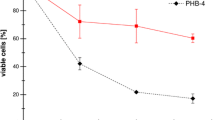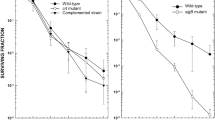Abstract
The effect of glutathione (GSH) on the ultraviolet (UV) induction of lambda prophage was investigated in lysogenic Escherichia coli. The data showed that extracellular GSH could inhibit the UV induction of lambda prophage. The inhibitory rates were concentration dependent, and the maximal rate obtained was 94% with 3.0 M GSH. The effect was also measured in three different lambda lysogens: a wild-type strain (wt), an isogenic GSH-deficient strain, and an isogenic strain producing increased amounts of GSH. The result showed that when subjected to UV irradiation (254 nm, 60 J m−2), GSH-deficient strain was approximately fivefold more sensitive to be lysed than wt, whereas the strain with higher intracellular GSH levels was only 28% susceptible to be lysed. With electron spin resonance and spin trapping techniques, we observed that free radical signals occurred in the suspensions of UV irradiated lysogenic cells and the intensity of signals was influenced by GSH levels. These results indicate that GSH can significantly inhibit the UV induction of lambda prophage, and that this effect is correlated to its capacity to scavenge free radicals generated after UV irradiation.





Similar content being viewed by others
References
Barry H, John G (1985) Free radical in biology and medicine. Clarendon, Oxford, pp 57–118
Barry H, Okezie IA (1993) DNA and free radicals. Ellis Horwood Limited, England, pp 1–75
Cairo G, Recalcati S, Pietrangelo A, Minotti G (2002) The iron regulatory proteins: targets and modulators of free radical reactions and oxidative damage. Free Radic Biol Med 32:1237–1243
Chang MC, Uang BJ, Wu HL, Lee JJ, Hahn LJ, Jeng JH (2002) Inducing the cell cycle arrest and apoptosis of oral KB carcinoma cells by hydroxychavicol: roles of glutathione and resctive oxygen spiecies. Br J Pharmacol 135:619–630
Chesney JA, Eaton JW, Mahoney JR Jr (1996) Bacterial glutathione: a sacrificial defense against chlorine compounds. J Bacteriol 178:2131–2135
Datsenko KA, and Wanner BL (2000) One-step inactivation of chromosomal genes in Escherichia coli K12 using PCR products. Proc Natl Acad Sci USA 97:6640–6645
Ding H, and Demple B (1996) Glutathione-mediated destabilization in vitro of [2Fe-2S] centers in the SoxR regulatory protein. Proc Natl Acad Sci USA 93: 9449–9453
Fahey RC, Brown WC, Adams WB, Worsham MB (1978) Occurrence of glutathione in bacteria. J Bacteriol 133:1126–1129
Helmut S (1999) Glutathione and its role in the cellular function. Free Radic Biol Med 27:916–912
Herbert V, Shaw S, Jayatilleke E (1994) Most free radical injury is iron-related: It is promoted by iron, hemin, holoferitin and VC, and inhibited by desferoxamine and apoferitin. Stem Cells 12:289–303
Herskowitz I (1980) The lysis-lysogenic decision of phage lambda: explicit programming and responsiveness. Annu Rev Genet 14:399–445
Jeffrey HM (1972) Experiments in molecular genetics. Cold Spring Habour Laboratory, NY, pp 37–46
Johnson MK, Loo G (2000) Effects of epigallocatechin gallate and quercetin on oxidative damage to cellular DNA. Mutat Res 459:211–218
Marklund S (1976) Spectrophotometric study of spontaneous disproportionate of superoxide anion radical and sensitive directassay for superoxide dismutase. J Biol Chem 251:7504–7507
Mórocz M, Csiszár Á, Johnson RT (2003) Variation in sequence-specific repair of UV damage in human pericentromeric heterochromatin of different cell lines. Cancer Lett 193:189–197
Müller J, and Janz S (1993) Modulation of the H2O2-induced SOS response in Escherichia coli PO300 by amino acids, metal chelators, antioxidants, and scavengers of reactive oxygen species. Environ Mol Mutagen 22:157–163
Neil S, Ravinder JS, Kalyanaraman B (1996) The role of glutathione in the transport and catabolism of nitric oxide. FEBS Lett 382:223–228
Nicole HPC, Ivonne MCMR, Heleen W (2001) The interplay of glutathione-related processes in antioxidant defence. Environ Toxicol Pharmacol 10:141–152
Palmer H, Ohta M, Watanabe M (2002) Oxidative stress-induced cellular damage caused by UV and methyl viologen in Euglena gracilis and its suppression with rutin. J Photochem Photobiol 67:116–129
Podmore ID (1998) Vitamin C exhibits pro-oxidant properties. Nature 392:559
Ronald MA (1997) Principles of Microbiology. Wm. C. Brown, USA, pp 380–391
Saby S, Leroy P, Block JC (1999) Escherichia coli resistance to chlorine and glutathione synthesis in response to oxygenation and starvation. Appl Environ Microbiol 65:5600–5603
Saija A, Princi P, Pisani A, Lanza M, Scalese M, Aramnejad E, Ceserani R, Costa G (1994) Protective effect of glutathione on kainic acid-induced neuropathological changes in the rat brain. Gen Pharmacol 25:97–102
Sambrook J, Fritsch EF, Maniatis T (1989) Molecular cloning: a laboratory manual, 2nd edn. Cold Spring Harbor Laboratory Press, Cold Spring Harbor
Tyrrell RM, Keyse SM (1990) New trend in photobiology: the interaction of UV-A radiation with culture cells. J Photochem Photobiol 4:349–361
Watanabe K, Yamano Y, Murata K, Kimura A (1986) The nucleotide sequence of the gene for gamma-glutamylcysteine synthetase of Escherichia coli. Nucleic Acids Res 14:4393–4400
Zheng MF, Aslund F, Storz G (1998) Activation of the OxyR transcription factor by reversible disulfide bond formation. Science 279:1718–1721
Zhu SH, Fang CX, Zhu SQ, Peng F, Zhang LZ, Fan CP (2001) Inhibitory effects of Gynostemma Pentaphyllum on the UV induction of bacteriophage λ in lysogenic Escherichia coli. Curr Microbiol 43:299–301
Acknowledgements
We thank Dr. Barry L. Wanner for providing pKD46 and pKD3. We are also grateful to Dr. Qian Chen from the Technical Institute of Physics and Chemistry of CAS for ESR detection, and PhD. Jeff Clogston from the Ohio State University for his assistance during the revision of this paper.
Author information
Authors and Affiliations
Corresponding author
Rights and permissions
About this article
Cite this article
Liu, Y., Zhang, Q., Fang, C. et al. Effect of glutathione on UV induction of prophage lambda. Arch Microbiol 183, 444–449 (2005). https://doi.org/10.1007/s00203-005-0019-y
Received:
Revised:
Accepted:
Published:
Issue Date:
DOI: https://doi.org/10.1007/s00203-005-0019-y




